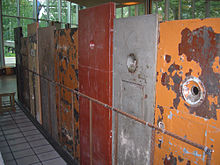Occupation Museum (Estonia)
The Occupation Museum ( Estonian : Okupatsioonide muuseum ) in the Estonian capital Tallinn deals with the Soviet and Nazi-German occupation of the country from 1940 to 1991.
Historical background of the exhibition
The Hitler-Stalin Pact confronted Estonia with the aggressors Soviet Union and Nazi Germany . In 1940 Estonia was occupied by Soviet troops and annexed as the Estonian Soviet Socialist Republic . From 1941 to 1944 it was occupied by German troops. Part of the Stalinist terror included deportations from Estonia that continued well into the 1950s, including the March deportations of 1949 . It was only with the collapse of the Soviet Union that Estonia managed to regain independence.
exhibition
The museum opened in 2003. The Latvian Occupation Museum in Riga, founded in 1993, is comparable . The exhibits deal with the fate of the people who were persecuted or who resisted at risk of death. An example of one of the victims is the soccer player Eduard Ellman-Eelma . In the basement of the museum there are busts and statues of politically responsible people who mostly fell victim to political purges.
Web links
- Official website of the museum (Estonian, English)
Coordinates: 59 ° 25 ′ 57.5 ″ N , 24 ° 44 ′ 22 ″ E

